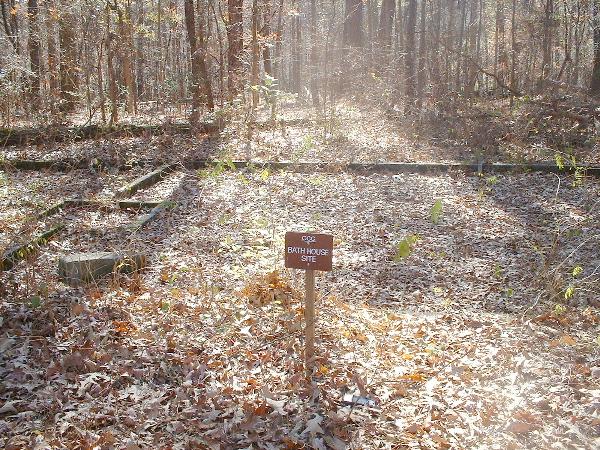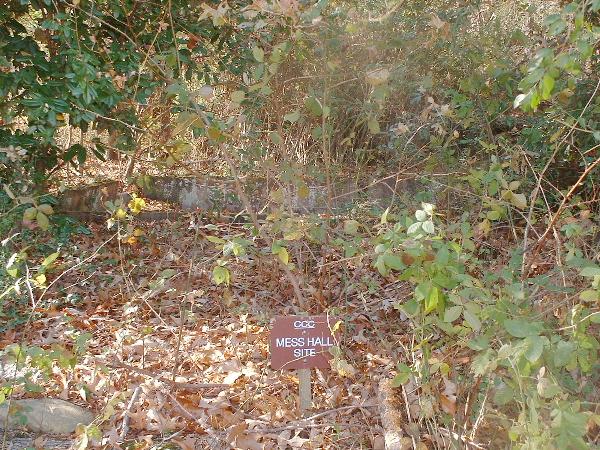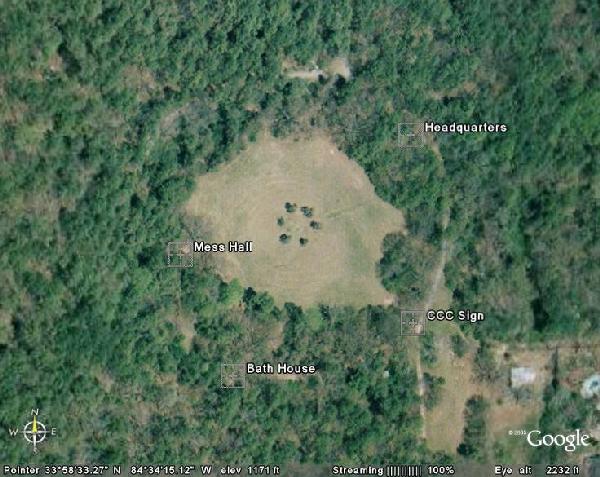During the 1930's a Civilian Conservation Corps "Company 431 Camp Ga NM-3 1938 - 1942 was established near Pigeon Hill at Kennesaw Mountain National Battlefield Park and workers from this camp were responsible for many of the improvements in the park, including almost all of the hiking trails.
CCC SIGN - N33 58.526 W84 34.207


HEADQUARTERS - N33 58.589 W84 34.208

BATH HOUSE - N33 58.508 W84 34.280

MESS HALL - N33 58.549 W84 34.301

Google Earth

The CCC impact in Georgia is measured by the structures still standing and the stories of the ones that have passed. Kennesaw Mountain NBP, Cloudland Canyon, Fort Mountain, Vogel, Unicoi, Moccasin Creek, Hard Labor Creek, Chickamauga - Chattanooga National Military Park, Lake Conasauga, the Pocket, and Lake Winfield Scott, bear structures created by the Corps. Brasstown Bald, and The Appalachian Trail, including the shelter on Blood Mountain and an inn at Neels Gap now known as Walesi-yi are also part of the legacy.
The Civilian Conservation Corps
As the country suffered the economic woes of The Great Depression, Franklin Delano Roosevelt extolled the virtues of hard work. It was in his acceptance of the Democratic nomination for president in July, 1932 that FDR began his conservation movement, proposing putting city men to work restoring the country to its "former beauty." According to Harry Rossoll, the Civilian Conservation Corps, or CCC, was "a massive salvage operation destined to become the most popular experiment of the New Deal."
It was on the day of his inauguration that President Roosevelt began creating an alphabet soup of agencies to help battle the economic and social problems that beset our country. In early March, 1933 he summoned Congress to our nation's capitol and in an emergency session on March 9th Congress heard his plan to enlist 250,000 men in an effort to "preserve the natural resources of these United States." Surprisingly, organized labor mounted a campaign against FDR's proposal, however, the bill was signed into law on March 31, 1933.
After passage of the act in 1933, Georgia quickly found a way to eliminate blacks from participation in the program. In spite of the unemployment rate for blacks being twice the rate for whites, all blacks were listed as "employed," making them ineligible to participate in the CCC. However, by May, 1933, Roosevelt called Democratic Governor Talmadge on the carpet, threatening him by withholding every penny of CCC money that would pour into the state. Talmadge quickly reconsidered and agreed to permit Blacks entry into the program, so long as they served in separate camps.
For two years Georgia and other states admitted more than 200,000 Black males into a program that over its lifespan of 8 years saw a total of 2.5 million men move through the camps. While early camps in northern states were occasionally integrated, by 1934 there was segregation throughout the organization. The presence of a Negro CCC camp near a town or village anywhere in the United States caused such problems that by 1934 the director of the program complained bitterly about the general attitude towards Blacks. Enrollment of these Americans into the Civilian Conservation Corps was curtailed in 1935, with the silent approval of Roosevelt.
From the initial crop of 250,000 boys the CCC grew to nearly 500,000 in 1936 when the number was to be reduced to 300,000 in an effort to balance the budget during an election year. An avalanche of mail from across the United States brought new life to the Corps, and the planned reduction was canceled, although within two years the reduction had been quietly carried out. From 1938 until 1942 the Corps continued to function near the 300,000 man level. Only the international situation in 1942 forced the end of the corps.
During its time there were many nicknames for the Civilian Conservation Corps, but the most common by far was "Roosevelt's Tree Army." This name stuck because the recruits were young men (hence the term "boys") who "enrolled" for a term of service, lived in "camps," much like the soldiers in an army. Each camp had a commanding officer, normally a lieutenant or colonel in the army, a mess hall, laundry and toolhouse. In general, the camps also had a rec(reaction) hall and canteen, where the men could buy candy and tobacco. Modular barracks made it easy to add to a camp or tear it down. In 1942, when the Corps disappeared, some of the housing was reused in local POW camps, or the determent camps of Japanese-Americans on the West Coast.
Each CCC "boy" would receive $30.00 a month. $25.00 would go to his wife or family and he kept the rest. When the corps had a problem with an enlistee the punishment ran the gamut from KP or extra duty to being given a ticket home.
One of the major tasks of the corps was reforestation. Much of the land in north Georgia and throughout the Southeast had been stripped bare and left as worthless. This land was bought at rock-bottom prices by the U. S. government and improved by the CCC. In addition to the reforestation, corps members would build roads and fire control trails, work on erosion control, or fight forest fires. Today's Chattahoochee National Forest was partially reforested with the help of the CCC.
To download a Garmin MapSource map with tracks & waypoints for the camp
Download Here